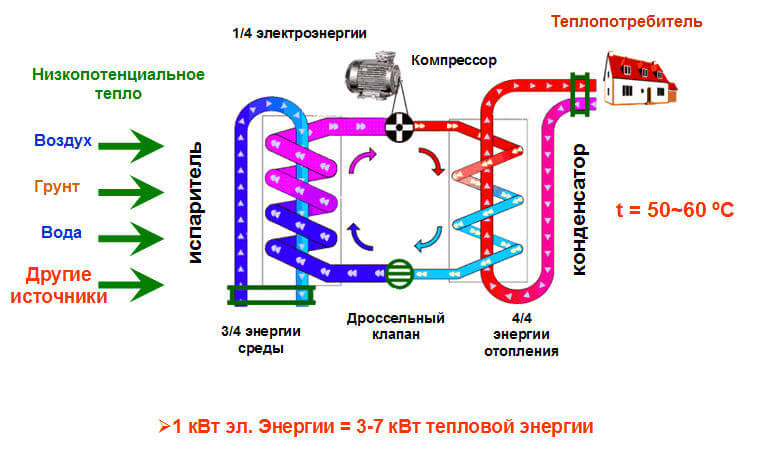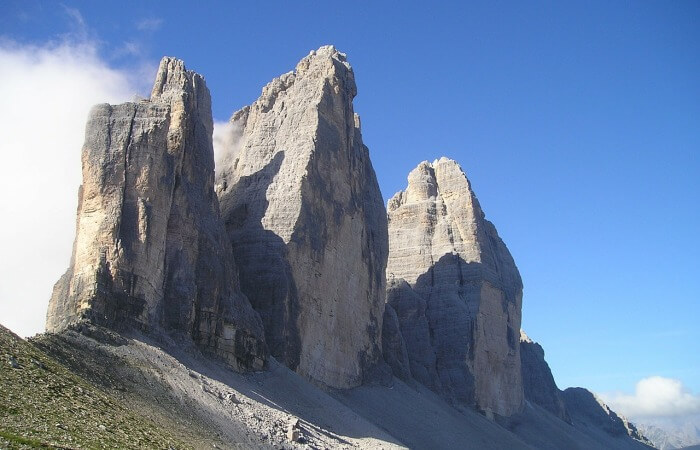Heat pump for house heating air water water price to buy your hands review the calculation unit plan under the key heat cost well option

Heat pump for home heating.
Heat pump device for transferring heat energy from a source of low-potential heat energy (with low temperature) to the consumer (heat carrier) with a higher temperature. From 1 kW of electricity consumed the heat pump is obtained from 3 to 7 kW of thermal energy. It’s more than fuel combustion.
Description:
Heat pump device for transferring heat energy from a source of low-potential heat energy (with low temperature) to the consumer (heat carrier) with a higher temperature. Source low-potential energy is water, earth, air.
Thermodynamic heat pump is similar to a refrigeration machine. In both there is the evaporator, compressor, condenser and expansion device.
However, if the appliance main purpose is the production of cold by taking heat from a volume of the evaporator and the condenser clears heat in the environment, the heat pump situation is reversed. The condenser is a heat exchanger, releasing heat to the consumer, and the evaporator — heat exchange apparatusutilizing low-grade heat: secondary energy resources and (or) non-traditional renewable sources of energy.
Working principle:
The scheme of heat pumps is quite simple and is based on the principle of reverse Carnot:

1. The coolant moving through the external circuit, is heated from the selected source and enters the evaporator.
2. In the evaporator, it exchanges energy with the refrigerant (usually freon).
3. Freon boils, it turns into a gaseous state and compressed.
4. Hot gas (heated in the range of 35-65 oC) is pumped into another heat exchanger which gives up its heat to the heating system or hot water at home.
5. The cooled refrigerant again becomes liquid and returns to a new cycle. The cycle of heat removal is repeated.
Advantages:
– high efficiency. Due to the high system efficiency is achieved with low power consumption. From spent 1 kW of electricity to work a heat pump is obtained from 3 to 7 kW of thermal energy. This is more than any boilers that use fuel,
– autonomy,
– universality. In one device combines both the water heating system, heating and cooling,
– fire safety,
– stop the operation of the heat pump does not lead to breakage of the heat pump or freezing of the liquid,
– reliability. The heat pump controls the automation. The service requires no special training,
– durability. Service life from 20 to 50 years
– runs almost silently,
– environmentally friendly – does not harm the environment.
Types of heat pumps:
– geothermal heat pumps. Use the heat of the earth, surface or underground sources of water:
– horizontal geothermal heat pumps. The outer contour is placed by the winding or rings in horizontal trenches below the freezing depth of soil (usually 2 m or more). Manufacturers minimum recommended distance between the tubes – 1.5 m, low – 1,2. Estimated value of the heat capacity per 1 m duct: in the clay – 50-60 W, sand – 30 to 40 watts for moderate latitudes in the North values less than. Thus, for installation of heat pump capacity of 10 kW required earth loop length of 350-450 m, for styling which will require a plot of land of about 400 m2 (20×20 m).
– vertical geothermal heat pumps. The external circuit is placed vertically in boreholes with a depth of up to 200m or in several wells to a depth of 50-70 m. Roughly 1 meter wells have 50-60 watts of thermal power. Thus, for installation of heat pump capacity of 10 kW is required borehole depth of about 170 m. it is Impractical to drill a deep well, it’s cheaper to make a few wells of lesser depth of 10-20 metres from each other,
– water heat pumps. The outer contour is wavy or rings in the reservoir (lake, pond, river) below the freezing depth. The depth should be at least 2 m. the energy conversion efficiency heat pump is the same as when the heat extraction from the ground. Estimated value of the heat capacity per 1 m duct – 30 watts. Thus, for installation of heat pump capacity of 10 kW must be installed in the lake contour length of 300 m. the pipeline does not pop up, 1 POG. m is set to about 5 kg of goods,
– air source heat pumps. The source of heat is the air,
– heat pumps using a derived (secondary) heat.



